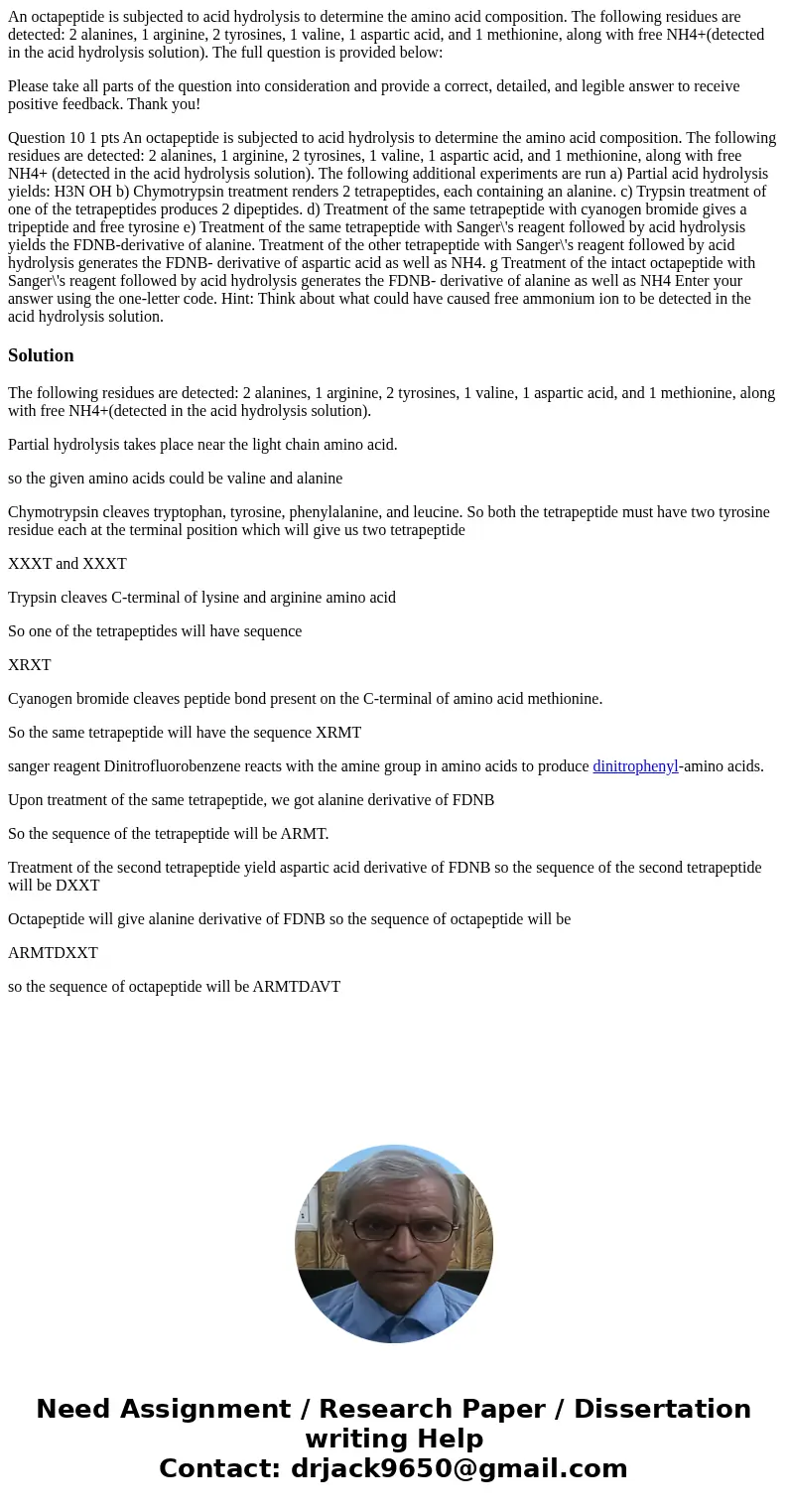An octapeptide is subjected to acid hydrolysis to determine
An octapeptide is subjected to acid hydrolysis to determine the amino acid composition. The following residues are detected: 2 alanines, 1 arginine, 2 tyrosines, 1 valine, 1 aspartic acid, and 1 methionine, along with free NH4+(detected in the acid hydrolysis solution). The full question is provided below:
Please take all parts of the question into consideration and provide a correct, detailed, and legible answer to receive positive feedback. Thank you!
Question 10 1 pts An octapeptide is subjected to acid hydrolysis to determine the amino acid composition. The following residues are detected: 2 alanines, 1 arginine, 2 tyrosines, 1 valine, 1 aspartic acid, and 1 methionine, along with free NH4+ (detected in the acid hydrolysis solution). The following additional experiments are run a) Partial acid hydrolysis yields: H3N OH b) Chymotrypsin treatment renders 2 tetrapeptides, each containing an alanine. c) Trypsin treatment of one of the tetrapeptides produces 2 dipeptides. d) Treatment of the same tetrapeptide with cyanogen bromide gives a tripeptide and free tyrosine e) Treatment of the same tetrapeptide with Sanger\'s reagent followed by acid hydrolysis yields the FDNB-derivative of alanine. Treatment of the other tetrapeptide with Sanger\'s reagent followed by acid hydrolysis generates the FDNB- derivative of aspartic acid as well as NH4. g Treatment of the intact octapeptide with Sanger\'s reagent followed by acid hydrolysis generates the FDNB- derivative of alanine as well as NH4 Enter your answer using the one-letter code. Hint: Think about what could have caused free ammonium ion to be detected in the acid hydrolysis solution.Solution
The following residues are detected: 2 alanines, 1 arginine, 2 tyrosines, 1 valine, 1 aspartic acid, and 1 methionine, along with free NH4+(detected in the acid hydrolysis solution).
Partial hydrolysis takes place near the light chain amino acid.
so the given amino acids could be valine and alanine
Chymotrypsin cleaves tryptophan, tyrosine, phenylalanine, and leucine. So both the tetrapeptide must have two tyrosine residue each at the terminal position which will give us two tetrapeptide
XXXT and XXXT
Trypsin cleaves C-terminal of lysine and arginine amino acid
So one of the tetrapeptides will have sequence
XRXT
Cyanogen bromide cleaves peptide bond present on the C-terminal of amino acid methionine.
So the same tetrapeptide will have the sequence XRMT
sanger reagent Dinitrofluorobenzene reacts with the amine group in amino acids to produce dinitrophenyl-amino acids.
Upon treatment of the same tetrapeptide, we got alanine derivative of FDNB
So the sequence of the tetrapeptide will be ARMT.
Treatment of the second tetrapeptide yield aspartic acid derivative of FDNB so the sequence of the second tetrapeptide will be DXXT
Octapeptide will give alanine derivative of FDNB so the sequence of octapeptide will be
ARMTDXXT
so the sequence of octapeptide will be ARMTDAVT

 Homework Sourse
Homework Sourse